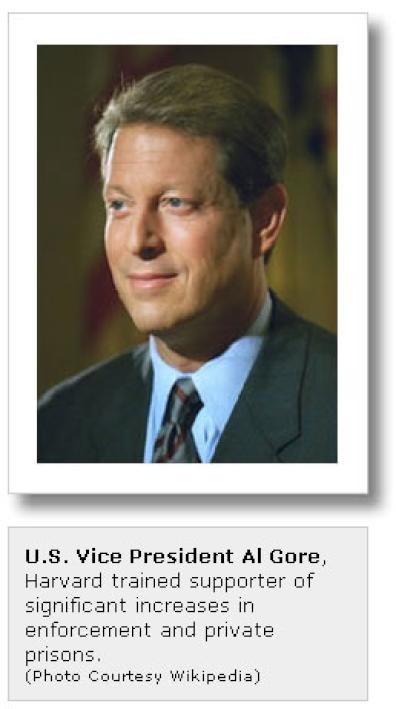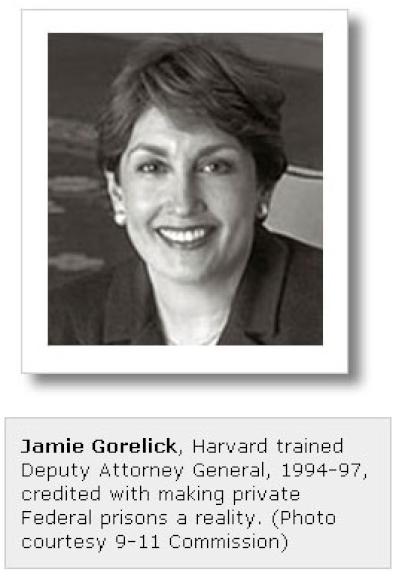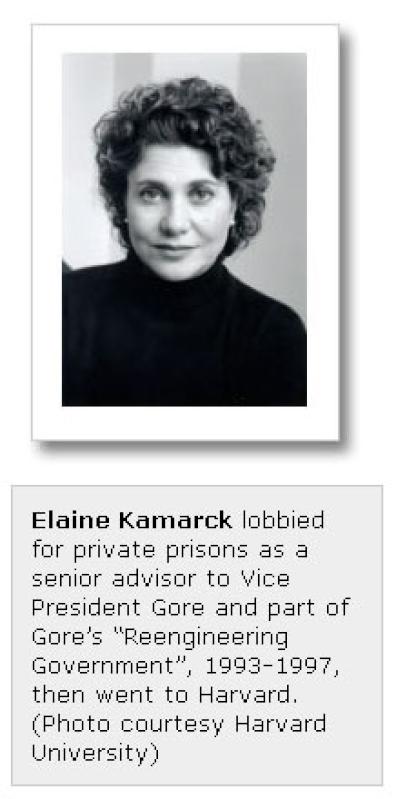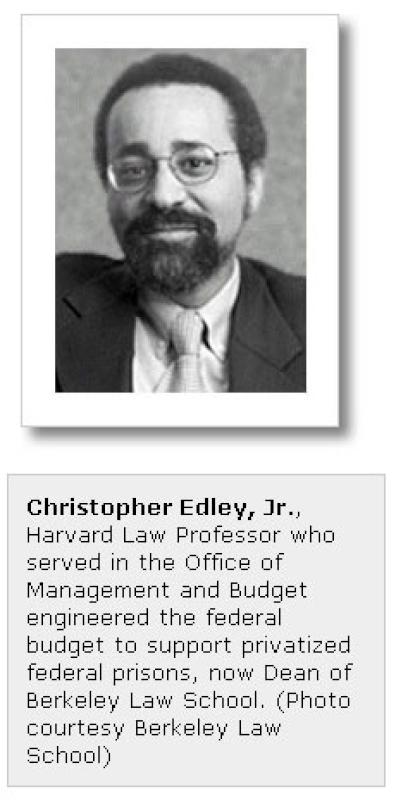Dillon Read (11): Clinton for For-Profit Prisons
A Serialised Story - Part 11 of 20 (publishing August/September 2007)
Dillon Read & Co. Inc.
And the Aristocracy of Stock
Profits
By Catherine Austin
Fitts
Click Here For Links To Other
Chapters
http://www.scoop.co.nz/stories/HL0708/S00302.htm#2
Chapter 10: The Clinton Administration:
Progressives for
For-Profit Prisons
Much has been written about the use of the War on Drugs to intentionally disenfranchise poor people and engineer the centralization of political and economic power in the U.S. and globally, including an explosive rise in the U.S. prison population. The purpose of this story is not to repeat this fundamentally sound thesis. For those who are interested in more on this topic, I would refer you to my article and audio seminar “Narco Dollars for Beginners” as well as Michael Woodiwiss’ book Organized Crime and American Power (University of Toronto Press, 2001) and their associated bibliographies.[49]

What most people miss is the extent to which the day-to-day implementation of this intentional centralism is deeply pervasive and therefore deeply bipartisan. It receives the promotion and support from all political and social spectrums that make money by running government through the contractors, banks, law firms, think tanks and universities that really run the government. My intention for this story is to make clear how the system really works. A system in which a small group of ambitious insiders — who more often than not were educated at Harvard, Yale, Princeton and the other Ivy League schools — enjoy centralizing power and advantaging themselves. Paradigms of Republican vs. Democrat or Conservative vs. Progressive have been designed for obfuscation and entertainment. An endless number of philosophies and strains of religious and “holier than thou” moralism are really put on and taken off like fresh make-up in the effort to hide from view a deeper, uglier face. One person who may have described it more frankly during the Clinton years was the former Director of the CIA, William Colby, who writing for an investment newsletter in 1995 said:
"The Latin American drug cartels have stretched their tentacles much deeper into our lives than most people believe. It's possible they are calling the shots at all levels of government."
The Clinton Administration took the groundwork laid by Nixon, Reagan and Bush and embraced and blossomed the expansion and promotion of federal support for police, enforcement and the War on Drugs with a passion that was hard to understand unless and until you realized that the American financial system was deeply dependent on attracting an estimated $500 billion-$1 trillion of annual money laundering. Globalizing corporations and deepening deficits and housing bubbles required attracting vast amounts of capital.

Jamie Gorelick, Harvard trained Deputy Attorney General, 1994-97, credited with making private Federal prisons a reality. (Photo courtesy 9-11 Commission)
Attracting capital also required making the world safe for the reinvestment of the profits of organized crime and the war machine. Without growing organized crime and military activities through government budgets and contracts, the economy would stop centralizing. The Clinton Administration was to govern a doubling of the federal prison population.[50]
Whether through subsidy, credit and asset forfeiture kickbacks to state and local government or increased laws, regulations and federal sentencing and imprisonment, the supremacy of the federal enforcement infrastructure and the industry it feeds was to be a Clinton legacy.
One of the first major initiatives by President Bill Clinton was the Omnibus Crime Bill, signed into law in September 1994. This legislation implemented mandatory sentencing, authorized $10.5 billion to fund prison construction that mandatory sentencing would help require, loosened the rules on allowing federal asset forfeiture teams to keep and spend the money their operations made from seizing assets, and provided federal monies for local police. The legislation also provided a variety of pork for a Clinton Administration vogue constituency — Community Development Corporations (CDCs) and Community Development Financial Institutions (CDFIs). The CDCs and CDFIs became instrumental during this period in putting a socially acceptable face on increasing central control of local finance and shutting off equity capital to small business.
The potential impact on the private prison industry was significant. With the bill only through the house, former Attorney General Benjamin Civiletti joined the board of Wackenhut Corrections, which went public in July 1994 with an initial public offering of 2.2 million shares. By the end of 1998, Wackenhut’s stock market value had increased almost ten times. When I visited their website at that time it offered a feature that flashed the number of beds they owned and managed. The number increased as I was watching it — the prison business was growing that fast.
However, the Clinton Administration did not wait for the Omnibus Crime Bill to build the federal enforcement infrastructure. Government-wide, agencies were encouraged to cash in on support in both Executive Branch and Congress for authorizations and programs — many justified under the umbrella of the War on Drugs — that allowed agency personnel to carry weapons, make arrests and generate revenues from money makers such as civil money penalties and asset forfeitures and seizures. Indeed, federal enforcement was moving towards a model that some would call “for profit” faster than one could say “Sheriff of Nottingham.”
On February 4, 1994, U.S. Vice President Al Gore announced Operation Safe Home, a new enforcement program at HUD. Gore was a former Senator from Tennessee. His hometown of Nashville was home of the largest private prison company, Corrections Corporation of America (CCA). He was joined at the press conference by Secretary of the Treasury Lloyd Bentsen, Attorney General Janet Reno, Director of Drug Policy Lee Brown and Secretary of HUD Henry Cisneros who said that the Operation Safe Home initiative would claim $800 million of HUD’s resources. Operation Safe Home was to receive significant support from the Senate and House appropriations committees. It turned the HUD Inspector General’s office from an auditor of program areas to a developer of programs competing for funding with the offices they were supposed to be auditing — a serious conflict of interest and built-in failure of government internal controls.

According to the announcement, Operation Safe Home was expected to "combat violent crime in public and assisted housing." As part of this program, the HUD Office of Inspector General (OIG) coordinated with various federal, state and local enforcement task forces. Federal agencies that partnered with HUD included the FBI, the Drug Enforcement Agency (DEA), the Bureau of Alcohol, Tobacco and Firearms (ATF), the Internal Revenue Service (IRS), the Secret Service, the U.S. Marshal's Service, the Postal Inspection Service, the U.S. Customs Service, the Immigration and Naturalization Service (INS) and the Department of Justice (DOJ). The primary performance measures reported in the HUD OIG Semi-Annual Performance Report to Congress for this program are the total number of asset forfeitures/seizures, equity skimming collections and arrests. Subsequent intra-agency efforts such as the "ACE" program sponsored by DOJ and initiated by U.S. Attorney’s Offices, working with the DOJ Asset Forfeiture Fund, HUD OIG and HUD Office of General Counsel promoted revenue generating activities as well.

Behind the scenes
what all this meant was big budget increases for DOJ and the
portions of the agencies that were focused on profitable
enforcement and the War on Drugs. Big budget increases meant
big contract budget increases as government outsourced more
and more work. In "Prisons for Profit: A special report;
Jail Business Shows Its Weaknesses," Jeff Gerth and Stephen
Labaton in the New York Times in November 1995 describe the
political appointees in the Clinton Administration who were
successful at overcoming the natural intelligence of the
career civil service at DOJ:
“In the middle of last year, the White House sent its proposal to privatize prisons to the Justice Department, where it was greeted with a frosty response, according to officials involved in the discussions.
Christopher Edley, Jr., Harvard Law Professor who served in the Office of Management and Budget engineered the federal budget to support privatized federal prisons, now Dean of Berkeley Law School. (Photo courtesy Berkeley Law School)
“To help overcome the resistance of senior officials at the Justice Department and the Bureau of Prisons, the plan's architect at the White House, Christopher Edley Jr., asked Mr. Gore's office to turn up the heat.
“Mr. Edley, an associate director of the Office of Management and Budget, enlisted the aid of Ms. Kamarck, Mr. Gore's senior policy adviser overseeing his government review. She then called her friend, Ms. Gorelick, the Deputy Attorney General, who oversees the day-to-day operations of the Justice Department.
“I convinced Jamie to do more of it," Ms. Kamarck recalled.”
Cornell Corrections was one of the beneficiaries of Chris Edley, Elaine Kamarck and Jamie Gorelick’s efforts. According to Cornell’s 1996 Prospectus (the offering document provided to investors) filed with the SEC, after building a capacity of approximately 1100 beds over a five year period, Cornell in a nine month period was suddenly blessed with a feeding frenzy of new contracts, contract renewals and contract acquisition approvals that nearly tripled their capacity — all from the Federal Bureau of Prisons at the Department of Justice.
| DATE | LOCATION | PRISONER CAPACITY | TYPE |
| 9/95 | Oakland | 61 | Pre-Release |
| 11/95 | San Diego | 50 | Pre-Release |
| 12/95 | Salt Lake | 58 | Pre-Release |
| 1/96 | Houston | 94 | Pre-Release * |
| 2/96 | San Francisco | 81 | Pre-Release |
| 2/96 | Big Spring, Texas | 1305 | Secure |
| 3/96 | Santa Barbara | 25 | Pre-Release |
| 4/96 | El Monte, California | 52 | Pre-Release |
|
|
| TOTAL 1726 |
|
| Note: * This location is named the Peter A. Liedel Community Center after Cornell board member and Dillon Read officer Peter A. Liedel. | |||
The acquisition of the Big Spring, Texas facilities from MidTex, signed in February of 1996 and closed in July 1996 brought on board Charles J. Haugh to be Cornell’s Director of Secure Institutions as of May 1997. Haugh had most recently been the Executive Director of MidTex. From 1963 to 1988, Haugh had served in numerous capacities for the Federal Bureau of Prisons at DOJ, including Special Assistant to Director Administrator of Correctional Services Branch, Associate Warden, Chief Correctional Supervisor and Correctional Officer.
Gerth and Labaton in "Prisons for Profit" describe who in the Clinton Administration got it done:
“Federal officials say they are comfortable with letting private companies run Federal prisons because the industry has become mature, gaining experience running state and local jails. But Federal officials have also grown comfortable with the prison industry because its ranks now include many former colleagues as senior and other law-enforcement officials have taken positions at private corrections companies, Washington's latest revolving door profession.
“The industry leader is the Corrections Corporation of America, a 12-year-old company based in Nashville. Some of the company's officials are former Federal prison employees, and the company's director of strategic planning, Michael Quinlan, headed the Bureau of Prisons in the Bush Administration.
“Another industry leader is the Wackenhut Corrections Corporation of Coral Gables, Florida. Its directors include Norman A. Carlson, Mr. Quinlan's predecessor as the director of the prisons bureau, and Benjamin R. Civiletti, a former Attorney General.
“The Acting Attorney General in the first months of the Clinton Administration, Stuart Gerson, is on the board of Esmor Correctional Services of Sarasota, Fla. Four months ago, the Immigration and Naturalization Service, a unit of the Justice Department, canceled its contract with Esmor after an uprising at its detention center in Elizabeth, N.J. An investigation by immigration officials concluded that Esmor, trying to cut costs, had failed to train guards, some of whom beat detainees.
“The revolving door is beginning to work both ways. Not only has the private sector turned to former Federal officials, the Government has also started to look to industry leaders for aid in developing plans to hand new prisons over to private management.
“Mr. Crane, a general counsel at the Corrections Corporation in the 1980s, was retained briefly as a consultant by the Bureau of Prisons to help write a model contract that is going to be used to hire the company to run the Federal prison in Taft.”
The Mr. Crane who they have hired to develop the contract is the same Mr. Crane who arranged for the prisoners to be shipped from North Carolina to Rhode Island to save Cornell Corrections and Dillon Read’s municipal bond buyers.
The outpouring of contracts from the Department of Justice to Cornell was very significant. When Cornell did its IPO in October of 1996, I estimate it had an implied “per bed” or “per prisoner” valuation of $24,241. Valuing the company at the IPO price, the total company value was $81 million. Without the contracts from the Federal Bureau of Prisons, the company value would have been approximately $39 million, assuming the company could have held a $24,241 per prisoner multiple or come to market at all — both unlikely in my opinion. The increase in total valuation of stock held by Dillon and its funds based on these assumptions would have been a minimum of $18.5 million. In short, the Dillon Read officers and directors invested in Cornell experienced a more than double in the increase in their value of their personal holdings of Cornell stock as a result of six months of contract decisions by DOJ and its agencies.
Deputy Attorney General Jamie Gorelick, who according to the New York Times article had overseen the new policy of prison privatization, left DOJ in 1997. She then became a Vice Chair of Fannie Mae, a “government sponsored enterprise.” This means it is a private company that enjoys significant governmental support. Fannie Mae buys mortgages and combines them in pools. They then sell securities in these pools as a way of increasing the flow of capital to the mortgage markets.
The reader can appreciate why Wall Street would welcome someone as accommodating as Gorelick at Fannie Mae. This was a period when the profits rolled in from engineering the most spectacular growth in mortgage debt in U.S. history.[51] As one real estate broker said, “They have turned our homes into ATM machines.” Fannie Mae has been a leading player in centralizing control of the mortgage markets into Washington D.C. and Wall Street. And that means as people were rounded up and shipped to prison as part of Operation Safe Home, Fannie was right behind to finance the gentrification of neighborhoods. And that is before we ask questions about the extent to which the estimated annual financial flows of $500 billion–$1 trillion money laundering through the U.S. financial system or money missing from the US government are reinvested into Fannie Mae securities.
It is important before closing this description of Cornell’s extraordinary good fortune with the Federal Bureau of Prisons and DOJ in the fall of 1995 and the spring and summer of 1996 to provide some additional context. During this period, America was in the middle of a Presidential election. Bill Clinton and Al Gore were running for their second term. Dillon Read was a traditionally Republican firm, with the largest Dillon investors in Cornell giving generously to the Republican Party as well as to the Dole-Kemp campaign, whose campaign manager, Scott Reed, had been Kemp's chief of staff at HUD and then Executive Director of the Republican Party. The corporate ancestry and relations of Cornell — Bechtel, Houston, their auditor, Arthur Anderson’s Houston office, their attorney, Baker Botts, and their construction company, Halliburton/KBR — are ties all deeply associated with the Bush family and Republican camp.
| Contributor | Date | Amount | Recipient |
| David Niemiec | 10/29/1996 | ($250) | Weld, William F |
| Franklin Hobbs | 10/24/1996 | $1,000 | Weld, William F |
| Franklin Hobbs | 10/23/1996 | ($2,000) | Weld, William F |
| Peter Flanigan | 10/22/1996 | $450 | National Republican Senatorial Committee |
| Peter Flanigan | 10/16/1996 | $500 | Hutchinson, Tim |
| John Haskell | 10/14/1996 | $500 | National Republican Senatorial Committee |
| Peter Flanigan | 10/3/1996 | $500 | Cubin, Barbara |
| David Niemiec | 10/3/1996 | $5,000 | National Republican Congressional Committee |
| John Haskell | 9/13/1996 | $1,000 | RNC/Repub National State Elections Committee |
| David Niemiec | 8/30/1996 | $1,000 | Molinari, Susan |
| John Haskell | 8/29/1996 | $15,000 | RNC/Repub National State Elections Committee |
| Peter Flanigan | 8/12/1996 | $1,000 | RNC/Repub National State Elections Committee |
| David Niemiec | 8/7/1996 | $1,000 | Paxon, Bill |
| Peter Flanigan | 8/5/1996 | $500 | Weld, William F |
| Peter Flanigan | 7/31/1996 | $40,000 | RNC/Repub National State Elections Committee |
| Peter Flanigan | 5/28/1996 | $1,000 | Sessions, Jeff |
| John Haskell | 5/17/1996 | $500 | Livingston, Jeffrey |
| David Niemiec | 5/1/1996 | $5,000 | National Republican Congressional Committee |
| Peter Flanigan | 4/30/1996 | $5,000 | Republican National Committee |
| David Niemiec | 4/30/1996 | $15,000 | Republican National Committee |
| John Birkelund | 4/19/1996 | $1,000 | Dole, Bob |
| David Niemiec | 3/21/1996 | $5,000 | National Republican Congressional Committee |
| John Haskell | 3/8/1996 | $365 | New York Republican Campaign Committee |
| Peter Flanigan | 2/29/1996 | $250 | Cubin, Barbara |
| George Wiegers | 2/26/1996 | $1,000 | Alexander, Lamar |
| Franklin Hobbs | 2/23/1996 | $1,000 | Weld, William F |
| Kenneth Schmidt | 2/21/1996 | $500 | Alexander, Lamar |
| David Niemiec | 2/12/1996 | $250 | Weld, William F |
| Peter Flanigan | 2/2/1996 | $500 | New York Republican County Committee |
| Peter Flanigan | 1/29/1996 | $250 | Miller, James C III |
| John Haskell | 1/26/1996 | $1,000 | Smith, Gordon |
| Peter Flanigan | 1/23/1996 | $1,000 | Smith, Gordon |
| Peter Flanigan | 1/10/1996 | $1,000 | Weld, William F |
| Peter Flanigan | 1/2/1996 | $1,000 | National Republican Senatorial Committee |
| Peter Flanigan | 12/13/1995 | $15,000 | RNC/Repub National State Elections Committee |
| Franklin Hobbs | 12/9/1995 | $1,000 | Malcolm Forbes |
| Peter Flanigan | 12/6/1995 | $4,500 | Republican National Committee |
| David Niemiec | 11/22/1995 | $5,000 | Republican National Committee |
| John Haskell | 11/10/1995 | $1,000 | Boschwitz, Rudy |
| John Haskell | 11/7/1995 | $1,000 | Alexander, Lamar |
| John Haskell | 10/3/1995 | $200 | Millard, Charles |
| John Haskell | 8/31/1995 | $15,000 | Republican National Committee |
| Peter Flanigan | 7/31/1995 | $500 | Thompson, Fred |
| Franklin Hobbs | 7/13/1995 | $1,000 | Alexander, Lamar |
| David Niemiec | 5/5/1995 | $5,000 | National Republican Congressional Committee |
| Peter Flanigan | 3/22/1995 | $500 | New York Republican County Committee |
| John Birkelund | 3/9/1995 | $1,000 | Alexander, Lamar |
| John Birkelund | 3/7/1995 | $1,000 | Time Future Inc |
| Peter Flanigan | 2/25/1995 | ($1,000) | Gramm, Phil |
| Peter Flanigan | 2/22/1995 | $15,000 | Republican National Committee |
| Peter Flanigan | 2/14/1995 | $1,000 | Dole, Bob |
| Peter Flanigan | 1/27/1995 | $250 | Alexander, Lamar |
| Peter Flanigan | 1/25/1995 | $2,000 | Gramm, Phil |
| * Preliminary,
Subject to Change | |||

If you want to see a bi-partisan system at work, follow the money. In the middle of a Presidential election, a Democratic administration engineered significant equity value into a Republican firm’s back pocket. If you step back and take the longer view, however, what you realize is that many of the players involved appear to have connections to Iran Contra and money laundering networks. A surprising number of them went to Harvard and other universities whose endowments are significant players in the investment world. And as it turned out, while the U.S. prison population was soaring from 1 million to 2 million people and US government and consumer debt was skyrocketing, Harvard Endowment was also growing — from $4 billion to $19 billion during the Clinton Administration. Harvard and Harvard graduates seemed to be in the thick of many things profitable.
FOOTNOTES[49] See Narco Dollars for Beginners by Catherine Austin Fitts (http://www.narconews.com/narcodollars1.html) and Organized Crime and American Power: a History by Michael Woodiwiss (http://www.powells.com/biblio/62-0802047009-3).
[50] See Prison Nation: The Warehousing of America’s Poor, edited by Tara Herivel and Paul Wright, page 72 (http://www.powells.com/s?kw=%22Prison+nation%3A+warehousing%22&x=0&y=0).
[51] After 9-11, when Nick Brady’s old friend Governor Tom Kean (Brady lead his transition team when he was elected Governor of New Jersey) chaired the 9-11 Commission, Jamie Gorelick was chosen as a Commissioner. Reports at that time describe her role at DOD and DOJ.
 Mapping The Real Deal is a column on
Scoop supervised by Catherine Austin Fitts. Ms Fitts is the
President of Solari, Inc. http://www.solari.com/. Ms. Fitts is
the former Assistant Secretary of Housing-Federal Housing
Commissioner during the first Bush Administration, a former
managing director and member of the board of directors of
Dillon Read & Co. Inc. and President of The Hamilton
Securities Group,
Inc.
Mapping The Real Deal is a column on
Scoop supervised by Catherine Austin Fitts. Ms Fitts is the
President of Solari, Inc. http://www.solari.com/. Ms. Fitts is
the former Assistant Secretary of Housing-Federal Housing
Commissioner during the first Bush Administration, a former
managing director and member of the board of directors of
Dillon Read & Co. Inc. and President of The Hamilton
Securities Group,
Inc.


 Binoy Kampmark: Fallibility, Dirty Wars And Pope Francis I
Binoy Kampmark: Fallibility, Dirty Wars And Pope Francis I Peter Dunne: Dunne's Weekly - An Issue No-one Can Afford To Lose
Peter Dunne: Dunne's Weekly - An Issue No-one Can Afford To Lose Martin LeFevre - Meditations: Choosing Mass Murder?
Martin LeFevre - Meditations: Choosing Mass Murder? Eugene Doyle: Quiet Mutiny - The U.S. Army Falls Apart
Eugene Doyle: Quiet Mutiny - The U.S. Army Falls Apart Gordon Campbell: Papal Picks, And India As A Defence Ally
Gordon Campbell: Papal Picks, And India As A Defence Ally Binoy Kampmark: The Selling Of America - Ending The US Dollar’s Exorbitant Privilege
Binoy Kampmark: The Selling Of America - Ending The US Dollar’s Exorbitant Privilege